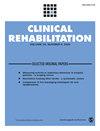干扰电流疗法加运动与假性干扰电流疗法加运动对缓解膝骨关节炎患者疼痛的疗效比较:随机对照试验
IF 2.6
3区 医学
Q1 REHABILITATION
引用次数: 0
摘要
研究设计双盲随机对照试验.地点康复门诊.受试者膝关节骨性关节炎患者,年龄 50-85 岁,疼痛评分≥4/10.方法将 144 名受试者随机分配到研究组和对照组。研究组接受 20 分钟的 IFC 治疗(载波频率:4000 Hz,节拍频率:100 Hz),每周五次,持续三周;对照组接受相同方案的假 IFC,随后两组均进行 10 分钟的锻炼。结果测量包括疼痛数字评分量表、西安大略和麦克马斯特大学指数(WOMAC)评分、步速和 EuroQol-Five Dimensions-Five Levels 问卷,分别在基线、第 3 周和第 6 周进行评估。结果第3周时,与对照组相比,研究组在疼痛数字评分量表、WOMAC总分、WOMAC疼痛和WOMAC僵硬度方面均有统计学改善。组间平均差异(95% 置信区间)分别为 0.76(0.21-1.30)、0.49(0.03-0.95)、0.63(0.13-1.13)和 0.62(0.04-1.20)。然而,各组间的平均差异均低于每项结果的最小临床重要差异值。结论 IFC 对轻度至中度膝骨关节炎患者减轻疼痛和改善功能没有影响。本文章由计算机程序翻译,如有差异,请以英文原文为准。
Efficacy of interferential current therapy plus exercise compared to sham interferential current plus exercise for pain relief in patients with knee osteoarthritis: A randomised controlled trial
ObjectiveTo compare the efficacy of interferential current (IFC) therapy combined with quadriceps strengthening exercise versus sham IFC plus exercise for pain relief and functional improvement in patients with knee osteoarthritis.Study DesignDouble-blind randomised controlled trial.SettingOutpatient rehabilitation clinic.SubjectsKnee osteoarthritis patients aged 50–85 years with a pain score ≥4/10.MethodsOne hundred forty-four participants were randomly allocated into the study and control groups. The study group received 20 min of IFC therapy (carrier frequency: 4000 Hz, beat frequency: 100 Hz) five times per week for three weeks, while the control group received sham IFC following the same protocol, followed by 10 min of exercise in both groups. Outcome measures included Numeric Rating Scale for Pain, Western Ontario and McMaster Universities Index (WOMAC) score, gait speed, and EuroQol-Five Dimensions-Five Levels questionnaire assessed at baseline, Week 3, and Week 6. Adverse events and patient satisfaction were evaluated at Week 3.ResultsAt Week 3, the study group demonstrated statistical improvement compared to the control group for Numeric Rating Scale for Pain, WOMAC Total, WOMAC Pain, and WOMAC Stiffness. The mean difference (95% confidence interval) between groups was 0.76 (0.21–1.30), 0.49 (0.03–0.95), 0.63 (0.13–1.13), and 0.62 (0.04–1.20), respectively. However, the mean differences between groups were below the Minimally Clinically Important Difference values for each outcome. Additionally, there were no significant differences between groups at Week 6 for any outcome measure.ConclusionIFC had no effect on pain reduction and functional improvement in patients with mild to moderate knee osteoarthritis.
求助全文
通过发布文献求助,成功后即可免费获取论文全文。
去求助
来源期刊

Clinical Rehabilitation
医学-康复医学
CiteScore
5.60
自引率
6.70%
发文量
117
审稿时长
4-8 weeks
期刊介绍:
Clinical Rehabilitation covering the whole field of disability and rehabilitation, this peer-reviewed journal publishes research and discussion articles and acts as a forum for the international dissemination and exchange of information amongst the large number of professionals involved in rehabilitation. This journal is a member of the Committee on Publication Ethics (COPE)
 求助内容:
求助内容: 应助结果提醒方式:
应助结果提醒方式:


